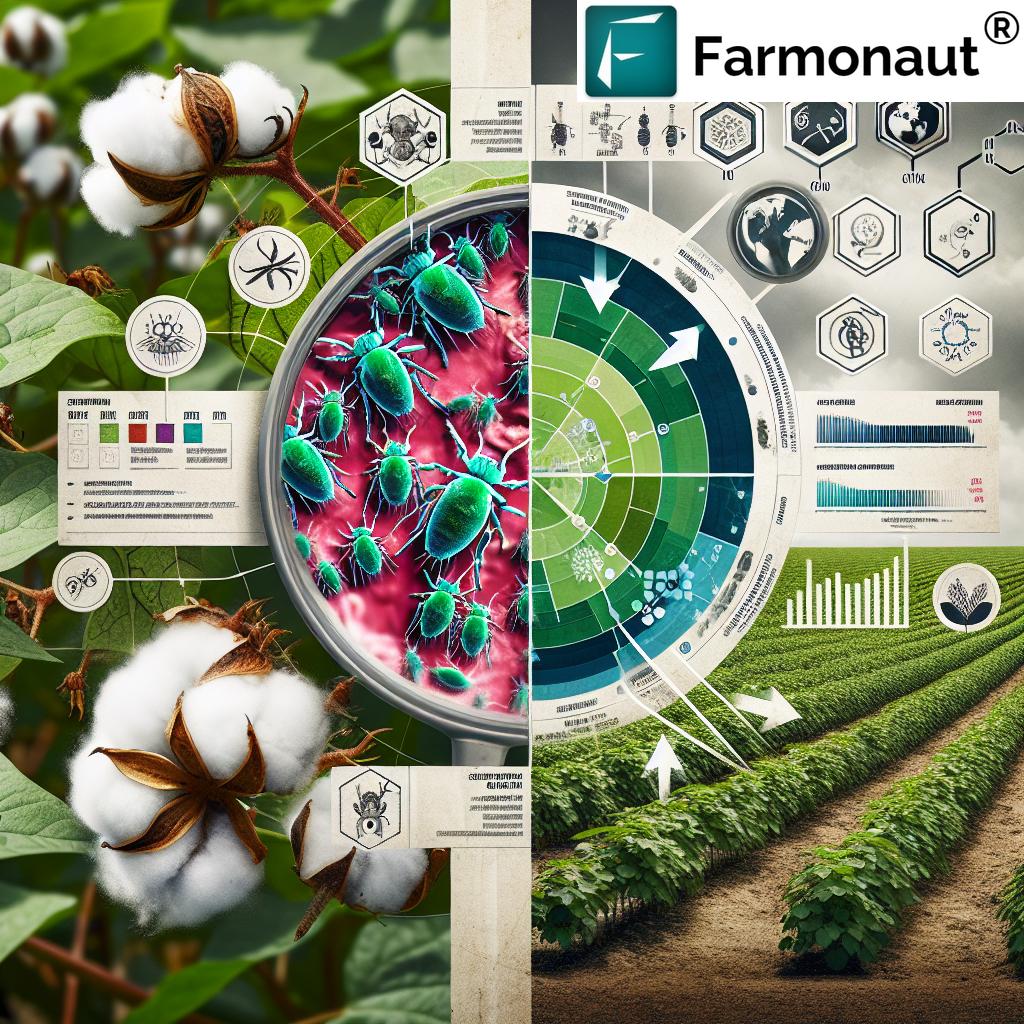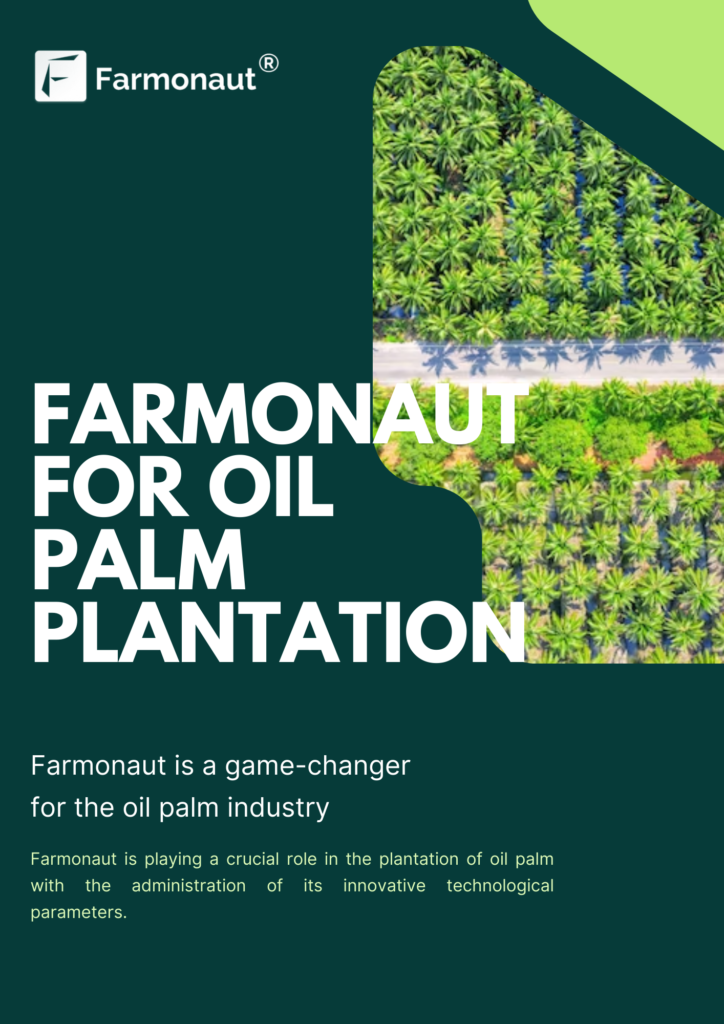Understanding Zinc Deficiency in Plants: Symptoms, Organic Control & Correction Measures for Crop Growth

In the world of agriculture, understanding and addressing nutritional disorders in plants is crucial for maintaining healthy crops and ensuring optimal yields. Among these disorders, zinc deficiency stands out as a significant concern for farmers and agronomists worldwide. At Farmonaut, we recognize the importance of identifying and correcting zinc deficiency to promote robust plant growth and maximize crop productivity.
What is Zinc Deficiency in Plants?
Zinc deficiency is a common nutritional disorder that occurs when plants are unable to access sufficient amounts of zinc from the soil. Zinc (Zn) is an essential micronutrient that plays a vital role in various plant metabolic processes, including:
- Enzyme activation
- Protein synthesis
- Chlorophyll formation
- Carbohydrate metabolism
- Auxin (growth hormone) production
When plants lack adequate zinc, their growth and development are compromised, leading to reduced yields and poor crop quality. As experts in precision agriculture, we at Farmonaut understand the importance of early detection and correction of zinc deficiency to ensure optimal crop performance.
Causes of Zinc Deficiency in Plants
Several factors can contribute to zinc deficiency in plants:
- Soil pH: High soil pH (alkaline soils) can reduce zinc availability to plants.
- Soil type: Sandy soils and soils with low organic matter content are more prone to zinc deficiency.
- High phosphorus levels: Excessive phosphorus in the soil can interfere with zinc uptake.
- Waterlogged conditions: Poor drainage can limit zinc availability.
- Cold temperatures: Low soil temperatures can reduce zinc uptake by plants.
- Intensive cropping: Continuous cultivation without proper nutrient replenishment can deplete soil zinc levels.
Recognizing Zinc Deficiency Symptoms in Plants
Identifying zinc deficiency early is crucial for implementing timely correction measures. Here are the common symptoms of zinc deficiency in plants:
- Interveinal chlorosis: Yellowing between leaf veins, particularly in young leaves.
- Stunted growth: Shortened internodes and reduced leaf size.
- Rosetting: Cluster formation of small, stiff leaves at the top of plants.
- Bronzing or purpling: Discoloration of leaves, especially in corn and sorghum.
- Delayed maturity: Slower development and late flowering.
- Reduced fruit or grain size: Smaller, often misshapen produce.

It’s important to note that zinc deficiency symptoms can vary depending on the crop species and severity of the deficiency. Our Farmonaut satellite-based crop monitoring system can help detect these symptoms early, allowing for prompt intervention.
Zinc Deficiency Detection Methods
Accurate detection of zinc deficiency is crucial for implementing effective correction measures. Here’s a comparison of different detection methods:
| Method | Accuracy | Cost | Time |
|---|---|---|---|
| Visual Inspection | Moderate | Low | Quick |
| Soil Testing | High | Moderate | Several days |
| Farmonaut Satellite System | High | Cost-effective | Real-time |
The Farmonaut Satellite System offers significant advantages in early detection, cost-effectiveness, and large-scale monitoring for zinc deficiency across crops. Our advanced technology allows for real-time monitoring of crop health, enabling farmers to identify and address zinc deficiency issues promptly.
Organic Control Measures for Zinc Deficiency
At Farmonaut, we advocate for sustainable farming practices. Here are some organic approaches to address zinc deficiency:
- Soil pH management: Maintain soil pH between 6.0 and 7.0 to optimize zinc availability.
- Organic matter incorporation: Add compost or well-rotted manure to increase soil organic matter content.
- Crop rotation: Implement a diverse crop rotation to prevent zinc depletion in the soil.
- Cover crops: Plant zinc-accumulating cover crops like oats or rye to improve soil zinc levels.
- Mulching: Apply organic mulch to regulate soil temperature and moisture, enhancing zinc uptake.
- Foliar application of organic zinc sources: Use zinc-rich seaweed extracts or chelated zinc products approved for organic farming.
Conventional Correction Measures for Zinc Deficiency
For conventional farming systems, the following correction measures can be implemented:
- Soil application of zinc sulphate: Apply zinc sulphate to the soil before planting or as a side-dressing during the growing season.
- Foliar sprays: Use zinc-containing foliar sprays for quick absorption by plants.
- Zinc-fortified fertilizers: Incorporate zinc-enriched NPK fertilizers into your fertilization program.
- Seed treatment: Treat seeds with zinc-containing products before planting.
- Chelated zinc applications: Use chelated zinc products for improved zinc availability in high pH soils.
The choice between organic and conventional methods depends on various factors, including soil conditions, crop type, and farming practices. Our Farmonaut platform can help you make informed decisions based on real-time crop health data.
Crop-Specific Zinc Management Strategies
Different crops have varying zinc requirements and susceptibility to deficiency. Here are some crop-specific strategies:
Cereals (Wheat, Rice, Corn)
- Apply 10-25 kg/ha of zinc sulphate to the soil before sowing.
- Foliar spray with 0.5% zinc sulphate solution at tillering and heading stages.
- Use zinc-enriched seeds for better early growth.
Fruit Trees (Citrus, Apple, Mango)
- Apply 50-100 g of zinc sulphate per tree, depending on age and size.
- Foliar spray with 0.3-0.5% zinc sulphate solution during active growth stages.
- Use zinc chelates for better absorption in alkaline soils.
Vegetables (Tomatoes, Peppers, Onions)
- Incorporate 5-10 kg/ha of zinc sulphate into the soil before planting.
- Foliar spray with 0.2-0.3% zinc sulphate solution every 2-3 weeks during the growing season.
- Use zinc-fortified compound fertilizers for balanced nutrition.
Legumes (Soybeans, Peanuts, Beans)
- Apply 10-20 kg/ha of zinc sulphate to the soil before planting.
- Foliar spray with 0.5% zinc sulphate solution at flowering and pod formation stages.
- Inoculate seeds with zinc-tolerant Rhizobium strains for improved nitrogen fixation.
Our Farmonaut platform can provide crop-specific recommendations based on satellite imagery and AI-driven analysis, ensuring optimal zinc management for your particular crop and field conditions.
The Role of Zinc in Plant Pest and Disease Resistance
Adequate zinc nutrition not only promotes healthy plant growth but also enhances a plant’s natural defense mechanisms against pests and diseases. Here’s how zinc contributes to pest and disease resistance:
- Strengthened cell walls: Zinc plays a crucial role in cell wall formation, making plants more resistant to pathogen invasion.
- Enhanced enzyme activity: Zinc activates enzymes involved in the production of defensive compounds.
- Improved root health: Adequate zinc nutrition promotes robust root systems, reducing susceptibility to soil-borne pathogens.
- Regulation of gene expression: Zinc influences the expression of genes related to disease resistance.
- Antioxidant properties: Zinc acts as a cofactor for enzymes that neutralize harmful free radicals produced during pathogen attacks.
By ensuring optimal zinc nutrition, farmers can reduce their reliance on chemical pesticides and promote a more sustainable approach to pest control. Our Farmonaut system can help monitor crop health and identify potential zinc deficiency-related vulnerabilities before they lead to pest or disease outbreaks.
Integrating Zinc Management with Precision Agriculture
At Farmonaut, we believe in leveraging technology to optimize zinc management in crops. Our satellite-based crop monitoring system offers several advantages:
- Early detection: Identify zinc deficiency symptoms before they become visible to the naked eye.
- Precision application: Create variable-rate application maps for targeted zinc treatments.
- Temporal analysis: Track the effectiveness of zinc correction measures over time.
- Large-scale monitoring: Efficiently manage zinc nutrition across vast agricultural areas.
- Data-driven decisions: Make informed choices based on real-time crop health data.
To leverage these benefits, farmers can sign up for our Farmonaut platform and start monitoring their crops’ zinc status with unprecedented accuracy and efficiency.
Economic Impact of Zinc Deficiency and the Value of Correction
Zinc deficiency can have significant economic implications for farmers. Here’s a breakdown of the potential costs and benefits:
Costs of Zinc Deficiency
- Reduced crop yields (up to 20-40% in severe cases)
- Lower crop quality and market value
- Increased susceptibility to pests and diseases, leading to higher pest control costs
- Reduced efficiency of other nutrient inputs
Benefits of Zinc Deficiency Correction
- Increased crop yields (10-30% improvement in deficient soils)
- Enhanced crop quality and nutritional value
- Improved resistance to environmental stresses
- Better overall nutrient use efficiency
- Potential for premium pricing for higher quality produce
Our Farmonaut system can help quantify these economic impacts by providing detailed crop health analyses and yield predictions. This information enables farmers to make cost-effective decisions regarding zinc management strategies.
Future Trends in Zinc Nutrition Management
As we continue to innovate in the field of precision agriculture, several emerging trends are shaping the future of zinc nutrition management:
- Nanotechnology: Development of nano-zinc fertilizers for enhanced efficiency and reduced environmental impact.
- Biofortification: Breeding crop varieties with improved zinc uptake and accumulation capabilities.
- Microbial inoculants: Utilizing zinc-solubilizing microorganisms to enhance zinc availability in soils.
- Sensor technology: Integration of real-time soil and plant sensors for continuous zinc status monitoring.
- AI-driven recommendations: Advanced algorithms for personalized zinc management strategies based on multi-factor analysis.
At Farmonaut, we’re at the forefront of these innovations, continuously updating our platform to incorporate the latest advancements in zinc nutrition management. Our API services allow developers and researchers to integrate our cutting-edge data into their own systems, fostering collaboration and innovation in the agtech sector.
Case Studies: Successful Zinc Deficiency Management
While we don’t include specific case studies or success stories, our experience with numerous farmers across diverse agricultural regions has demonstrated the effectiveness of proper zinc management. Common outcomes include:
- Yield increases of 15-25% in zinc-deficient soils after correction
- Improved crop quality and uniformity
- Enhanced drought tolerance in zinc-sufficient crops
- Reduced incidence of certain fungal diseases
- Better nitrogen use efficiency in crops with adequate zinc nutrition
These general observations highlight the importance of addressing zinc deficiency in agricultural systems. Our Farmonaut platform has been instrumental in helping farmers achieve such positive results through early detection and targeted management strategies.
Integrating Zinc Management into Sustainable Farming Practices
As the agricultural sector moves towards more sustainable practices, integrating zinc management into holistic farming approaches is crucial. Here are some ways to incorporate zinc nutrition into sustainable farming systems:
- Conservation agriculture: Implement minimum tillage practices to preserve soil structure and organic matter, which can improve zinc availability.
- Integrated nutrient management: Balance zinc application with other nutrients for optimal plant nutrition and soil health.
- Agroforestry: Incorporate zinc-accumulating tree species in agroforestry systems to improve soil zinc status naturally.
- Crop diversification: Rotate crops with different zinc requirements to maintain balanced soil zinc levels.
- Precision application: Use variable-rate technology guided by our Farmonaut system to apply zinc only where and when it’s needed, reducing waste and environmental impact.
By adopting these practices and utilizing our advanced monitoring tools, farmers can ensure optimal zinc nutrition while promoting long-term soil health and environmental sustainability.
The Global Impact of Addressing Zinc Deficiency in Crops
Addressing zinc deficiency in crops has far-reaching implications beyond individual farm productivity. Here’s how proper zinc management contributes to global agricultural and nutritional goals:
- Food security: Increased crop yields and resilience contribute to more stable food supplies.
- Nutritional quality: Zinc-rich crops help combat human zinc deficiency, a widespread nutritional issue.
- Economic development: Improved crop productivity enhances farmer incomes and rural economies.
- Environmental sustainability: Efficient zinc use reduces the need for excessive fertilizer application, minimizing environmental impacts.
- Climate change adaptation: Zinc-sufficient crops are better equipped to withstand environmental stresses associated with climate change.
At Farmonaut, we’re proud to contribute to these global objectives by providing farmers with the tools they need to optimize zinc management in their crops. Our technology empowers farmers to make data-driven decisions that benefit both their operations and the wider world.
Frequently Asked Questions (FAQ)
Q1: How quickly can zinc deficiency symptoms appear in plants?
A: Zinc deficiency symptoms can appear within 2-3 weeks of planting in severely deficient soils. However, mild deficiencies may take longer to manifest visibly. Our Farmonaut system can detect early signs of stress before they become visible to the naked eye.
Q2: Can excess zinc application be harmful to plants?
A: Yes, excessive zinc can be toxic to plants, leading to iron chlorosis and stunted growth. It’s crucial to apply zinc based on soil tests and crop requirements. Our precision agriculture tools help prevent over-application by providing accurate nutrient status information.
Q3: How does soil pH affect zinc availability?
A: Zinc availability decreases as soil pH increases. In alkaline soils (pH > 7.0), zinc can become less available to plants. Our soil analysis features can help you monitor pH levels and adjust zinc management strategies accordingly.
Q4: Are some crops more susceptible to zinc deficiency than others?
A: Yes, crops like corn, rice, beans, and citrus are generally more sensitive to zinc deficiency. Our crop-specific monitoring tools can help you manage zinc nutrition for various crop types effectively.
Q5: How often should I apply zinc fertilizers?
A: The frequency of zinc application depends on soil type, crop requirements, and management practices. Generally, zinc fertilizers are applied annually or bi-annually. Our Farmonaut system can provide tailored recommendations based on your specific field conditions and crop health status.
Q6: Can organic farming methods effectively address zinc deficiency?
A: Yes, organic methods such as using zinc-rich compost, green manures, and approved organic zinc fertilizers can effectively manage zinc nutrition. Our platform supports both organic and conventional farming practices with customized recommendations.
Q7: How does zinc deficiency affect crop quality beyond yield?
A: Zinc deficiency can reduce protein content, alter sugar composition, and decrease the nutritional value of crops. It can also affect the appearance and shelf life of produce. Our comprehensive crop health analysis helps you maintain both yield and quality standards.
Q8: Is foliar application of zinc more effective than soil application?
A: Foliar application can provide a quick response in addressing acute zinc deficiency, especially during critical growth stages. However, soil application is generally more effective for long-term management. Our system can help you determine the most appropriate method based on your crop’s current status.
Q9: How does zinc interact with other nutrients in the soil?
A: Zinc interacts with several nutrients, notably phosphorus, iron, and copper. High levels of phosphorus can induce zinc deficiency. Our nutrient management features take these interactions into account when providing recommendations.
Q10: Can zinc deficiency be confused with other nutrient deficiencies?
A: Yes, zinc deficiency symptoms can sometimes be confused with iron or manganese deficiency. Our advanced image analysis and spectral data interpretation help accurately distinguish between different nutrient deficiencies.
Conclusion
Understanding and managing zinc deficiency is crucial for maintaining healthy crops and ensuring optimal yields. By leveraging the power of satellite technology and precision agriculture, Farmonaut provides farmers with the tools they need to detect, monitor, and correct zinc deficiency effectively. Our comprehensive approach to nutrient management helps farmers make informed decisions, optimize their resources, and achieve sustainable, high-yield agriculture.
To start optimizing your crop’s zinc nutrition and overall health, sign up for our Farmonaut platform today. Our services are available through our Android and iOS apps, as well as our web interface. For developers interested in integrating our advanced agricultural data into their own systems, check out our API documentation.
Join us in revolutionizing agriculture through technology and data-driven insights. Together, we can address zinc deficiency and other nutritional challenges, ensuring a more productive and sustainable future for global agriculture.












